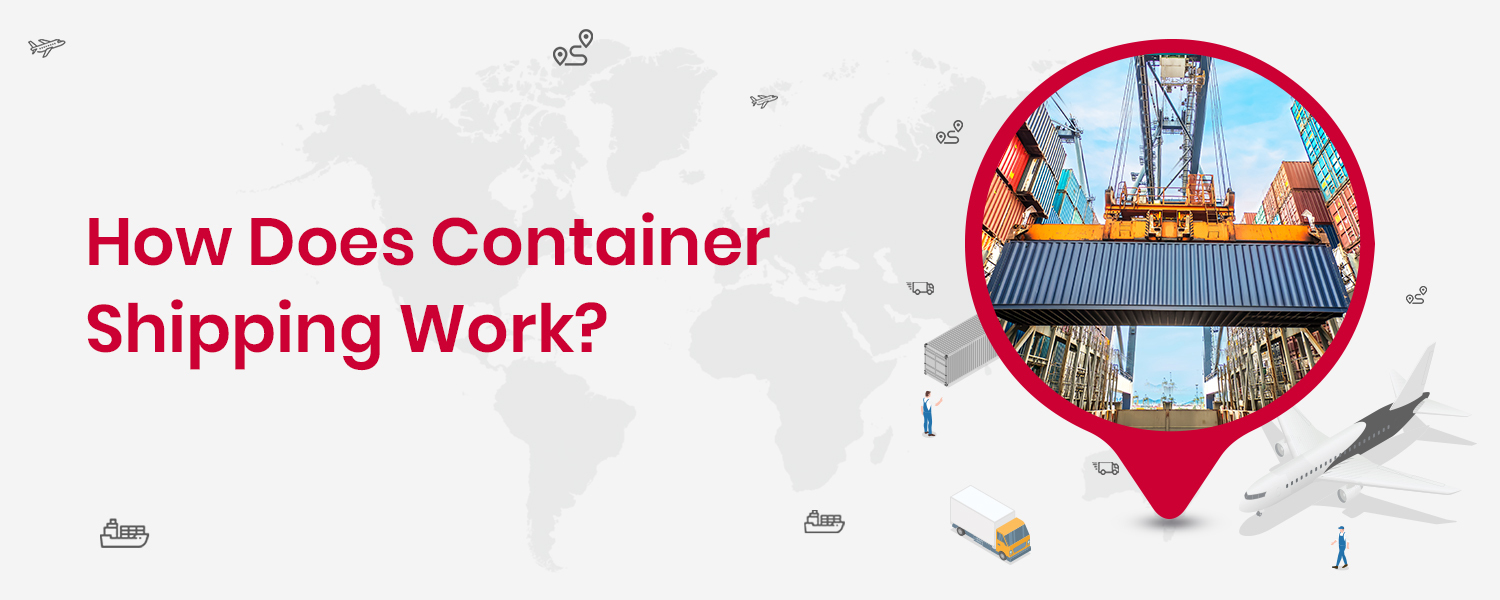In a world increasingly driven by the demand for rapid, seamless trade, the container shipping industry stands as a titan, streamlining the flow of goods across continents with precision and resilience. With a market poised to grow beyond $6.8 Billion in 2022, container shipping is the engine driving the global economy forward.
Yet, the seas are not always calm. The container shipping industry faces its share of storms, from overcapacity to environmental regulations and geopolitical tensions. But with every challenge comes innovation, smart containers, green fuels, and AI-driven algorithms plotting the most efficient course across the global trade routes.
Join us in this blog as we explore how container shipping works in an ever-evolving world.
Understanding What Container Shipping is
Container shipping is the method by which goods are transported across oceans and lands in standardised metal boxes, known as shipping containers. These containers safeguard the contents (your products) from the elements, theft, and damage while allowing for their efficient handling and transfer between ships, trucks, and trains.
This system is the backbone of global trade, enabling the movement of billions of dollars worth of goods annually across continents with precision and reliability. The significance of container standardisation underpins the entire global logistics ecosystem, facilitating not just economies of scale in shipping but also the advent of just-in-time manufacturing processes that rely on the timely and predictable delivery of components. It has made the global marketplace more accessible and interconnected, allowing businesses of all sizes to compete on the international stage.
Different Types of Shipping Containers
Dry Storage Containers
These types of containers are the workhorses of the shipping industry, offering a versatile solution for transporting a broad array of dry goods. These containers, typically available in 20ft and 40ft lengths, are the standard bearers for moving boxes, pallets, bales, and more. Their robust design and uniform sizes make them the backbone of international trade, facilitating the easy transfer of goods across different modes of transportation, from ships to trains to trucks.
Reefer Containers
These containers bring critical functionality to the shipping world, allowing for the safe transport of temperature-sensitive commodities. Whether it’s fruits from South America, vegetables from Africa, meats from Australia, or dairy products from Europe, reefer containers maintain the necessary conditions to preserve the quality of perishables across thousands of miles. Equipped with refrigeration units, these containers can keep goods at precise temperatures, from below freezing to just chilled, ensuring freshness from origin to destination.
Flat Rack Containers
These containers offer a solution for cargo that doesn’t conform to the size constraints of standard containers. With collapsible sides, flat racks are uniquely suited for heavy loads and oversized items like construction equipment, large machinery, or boats. This flexibility in loading and unloading, whether from the top or sides, makes flat rack containers invaluable for specialised shipments or even in bulk break cargo shipping.
Open Top Containers
These containers are designed without a fixed top to accommodate cargo that is too tall or bulky for standard containers. These containers are particularly useful for heavy machinery and industrial parts that require crane loading. With a removable roof or tarpaulin, open-top containers ensure that height is not a barrier to efficient shipping.
Tank Containers
Tank containers are the solution for liquid cargo, from chemicals and fuels to food-grade products. These containers are engineered to the highest safety standards to prevent leaks and contamination, ensuring that liquids are transported securely and efficiently. Their specialised design allows for the safe and effective movement of liquid goods across the globe.
Specialised Containers
These containers cater to niche markets and specific cargo needs. For instance, Garmentainers are designed to transport hanging garments without folding, preserving their condition. Insulated or Thermal Containers protect goods from extreme temperatures, offering an alternative to refrigerated containers for less sensitive cargo. Bulk containers are used for transporting bulk materials like grains or powders, optimising the heavyweight shipment of commodities that are not suited for standard containers.
What is the Process of Container Shipping?
Container Packing
The selection of containers is a critical first step, where the right type of container—be it standard dry storage, reefer, or specialised variant—is chosen based on the cargo’s specific requirements. Efficient packing strategies like protecting with dunnages are then employed to maximise space utilisation and minimise damage during transit, with a keen eye on safety and compliance with international standards.
Container Hauling to the Port
This involves the inland transportation of containers to the port, which can be achieved through a combination of trucks, rail, or even inland waterways, depending on the geography and infrastructure. The preparation of necessary documentation for customs clearance plays a pivotal role in this stage, as it facilitates a smooth transition through port authorities. Pre-port processing involves the inspection and staging of containers, ensuring they are ready for their maritime voyage.
Container Loading onto Ships
This is where the precision of logistics truly comes to the forefront. Scheduling and staging are critical, as containers must arrive and be aligned with ship schedules and port operations to avoid delays. Modern ports utilise advanced cranes and equipment to load containers onto the vessel efficiently. Stowage planning is essential for the safety and balance of the ship, with containers strategically placed to facilitate efficient unloading upon arrival at the destination port.
Maritime Transport
The Maritime Transport stage is where the vessel starts its journey across the seas. Route planning is undertaken to determine the most efficient and safe maritime routes, considering weather conditions, maritime traffic, and geopolitical considerations. Ship operations encompass navigating, maintaining, and managing the vessel during transit, with continuous monitoring and tracking of the container’s status and location through advanced technology, ensuring real-time visibility for logistics partners and customers alike.
Unloading and Delivery Process
This stage requires seamless interaction between port operations and the vessel’s crew. The containers undergo customs and clearance procedures, ensuring all regulatory requirements are met before the goods can be released. Final haulage then takes place, delivering the container to its final recipient via local transportation methods. This could involve trucks, rail, or other modes of transport, depending on the destination’s infrastructure.
Key Players in Container Shipping
Shipping Lines
Shipping Lines are the backbone of the container shipping industry. They own and operate the vessels traversing our oceans, carrying millions of containers yearly. These companies manage maritime shipping route schedules and have fleets that range from small coastal feeders to massive ships capable of carrying tens of thousands of TEUs (Twenty-Foot Equivalent Units). Shipping lines ensure that goods are moved efficiently across seas, navigating the logistical challenges of maritime transport, from weather conditions to regulatory compliance across different jurisdictions.
Freight Forwarders
Freight Forwarders act as the middlemen of the shipping, coordinating the movement of goods from manufacturers to markets. They do not own ships but specialize in navigating the complexities of international shipping, including customs clearance, documentation, and logistics. Freight forwarders are the crucial link between shippers and transport services, optimizing routes, consolidating shipments to reduce costs, and providing expert advice to ensure efficient and cost-effective order fulfillment.
Port Operators
Port Operators manage the gateways through which goods enter and exit countries. They oversee the operations of seaports, ensuring that container loading, unloading, and storage are carried out smoothly and efficiently. This includes the management of container terminals, where advanced crane machinery and automation technology are often employed to handle the vast numbers of containers processed daily. Port operators work closely with shipping lines, customs, and logistics companies to minimize delays and maximize throughput, facilitating the quick turnaround of ships and ensuring that cargo reaches its intended destination on time.
Logistics Companies
Logistics Companies, often encompassing a broader scope than freight forwarders, offer comprehensive supply chain solutions, including warehousing, distribution, and transportation by land, air, and sea. They are the architects of the supply chain, designing and managing the processes that ensure goods are moved from point A to point B most efficiently. To find the best logistics companies, use NimbusPost courier recommendation engine for the best recommendation.
Challenges and Solutions in Container Shipping
Overcapacity
Overcapacity poses a significant challenge stemming from a mismatch between supply and demand. This imbalance often leads to reduced freight rates, undercutting profitability for shipping lines. The solution lies in the deployment of sophisticated fleet management and demand forecasting software, enabling shipping companies to optimise vessel utilisation and align capacity with actual market demand.
Reduce the environmental footprint
The pressure to reduce the environmental footprint comes from both international bodies and local governments, urging the shipping industry to adopt greener practices. Innovations in fuel technology have led to the adoption of cleaner alternatives like LNG, methanol, and biofuels, significantly reducing greenhouse gas emissions. Moreover, investment in energy-efficient ship designs and retrofitting existing fleets with technologies that minimise emissions are steps forward in achieving regulatory compliance.
Geopolitical tensions
Geopolitical tensions and trade wars present another layer of complexity, impacting shipping routes, access to ports, and overall trade volumes. The industry’s response includes route diversification and developing alternative pathways to mitigate risks associated with geopolitical hotspots. Strategic alliances among shipping companies share risks and resources, providing a buffer against geopolitical uncertainties.
Extreme weather events
The threat of extreme weather events has escalated, increasing frequency and intensity, posing risks to maritime operations and supply chain continuity. Advanced weather forecasting technologies, leveraging AI and satellite data, offer improved prediction and avoidance of severe weather conditions, enabling ships to navigate safer routes. Dynamic routing tools adjust real-time paths based on weather updates, optimising safety and efficiency.
Conclusion
With its blend of tradition and innovation, the container shipping industry shows human ingenuity and resilience. As it continues to go through challenges and embrace new technologies, its role in connecting the world and fostering economic growth remains indispensable. You as a business must look forward to the advancements and opportunities that lie ahead and be ready to sail into the future of container shipping with optimism and determination.
FAQs
What is the cost of shipping a container?
Shipping a 20-ft container from India to the United States can cost around $1223.86-$1332.68.
What is the shipping outlook for 2024?
The shipping outlook for 2024 is characterised by continued technological advancements and a strong focus on sustainability. The industry is expected to see further adoption of green fuels and energy-efficient ships alongside the integration of AI and IoT for enhanced operational efficiency and real-time tracking. Despite facing challenges, the sector is poised for growth, driven by innovations and a commitment to reducing environmental impact.
Why do shipping containers only last 25 years?
The lifespan of a shipping container largely depends on its condition and the environment it’s kept in. However, a shipping container’s durability can last ever over 25 years if it is maintained properly.




